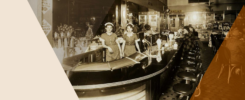Transcript for Episode 4 of the 2023 Season of Talking Hoosier History
Written and produced by Jill Weiss Simins. Performed by Justin Clark.
While the drumbeats of war sounded across Europe, the parading Hoosiers in Terre Haute carried banners reading “Help Win the War” and “We Are Ready to Give Our All of America,” demonstrating their patriotism and support for the U.S. men fighting abroad. Every person carried an American flag as they approached the post office, where they swore a public oath of loyalty to the United States. Because while these parade participants were clearly patriots, they were also Hungarian immigrants who were not yet American citizens. And the U.S. government had declared them “enemy aliens.”
I’m Justin Clark and this is a short episode of Talking Hoosier History.
Escaping impoverished conditions in Hungary, over a million Hungarians immigrated to the United States between 1870 and 1920. By 1910, over 14,000 Hungarian immigrants settled in Indiana, with 452 making Vigo County their home. The language barrier combined with local mistrust of Eastern European immigrants meant that their job options were limited. But in Terre Haute industry was booming, creating a demand for workers willing to take on difficult and dangerous jobs in coal mining, manufacturing, and railroads.
Few companies had adequate safety regulations and none had insurance. So, the newcomers took care of each other, founding the First Terre Haute Hungarian Sick and Death Benefit Society, a self-funded insurance group with members’ dues supporting the families of members who were killed or injured at work. They later became the Verhovay Society, headed by Hungarian immigrant community leaders.
In addition to the occupational dangers they faced, companies were also paying immigrants lower wages. These were people eager to become citizens of the United States – a country promising them that “all men are created equal.” But the disparity in pay for newcomers did not reflect the proclaimed values of their new country. In response, the Hungarian immigrant workers joined labor unions and Socialist Party organizations and went on strike for better wages. The renowned historian Howard Zinn explained that “if patriotism means being true to the principles for which your country is supposed to stand, then certainly the right to dissent is one of those principles.” In fact, he called dissent “the highest form of patriotism.” The Hungarian immigrants who came to Terre Haute at the turn of the twentieth century made this kind of dissent their first act of patriotism. But the nationalism of WWI curtailed their work for better pay and working conditions, and they shifted their efforts to outward displays of loyalty to the U.S. to avoid persecution.
Let’s take a minute to talk about why this story is important. One of the most significant “values of history” is that studying the past can make us better citizens in the present. And an essential component of that study is being able to think critically about sources and perspectives. In this story about Hungarian immigrants during WWI, we see the parallel but conflicting ideals of nationalism and patriotism in play. Of course, this is complicated, and since we only have a few minutes together so let’s quickly unpack the difference between nationalism and patriotism.
The terms overlap in that they both refer to pride in one’s country but diverge from there. Nationalism is a political ideology that that focuses on a group’s shared racial or cultural background as the foundation for their national identity. Nationalists also make claims about the superiority of their nation over others around the world. Conversely, patriotism is a sentiment that unites people around shared values and ideas. And it’s inclusive of people of diverse backgrounds and varied ideas who may disagree on issues but share. In a democracy, love for and loyalty to their country.
Terre Haute’s residents of Hungarian origin were loyal to their new country’s ideals and core values, and they supported the U.S. position in WWI – even when the U.S. declared war on Germany’s ally Austria-Hungary. However, the nationalistic fervor of the period meant that some Americans felt that immigrants who did not share their racial or cultural background could not be patriots despite their allegiance to U.S. values. This meant that sometimes the rights of these immigrants, most of who were on the path to citizenship, were violated. And thus, the Hungarian immigrants halted their strikes for safety and equal pay in the workplace and focused on publicly demonstrating their loyalty. Let’s check back in with our story and see how this played out.
As WWI continued, Indiana schools stopped teaching German, and German-language newspapers in Terre Haute and across the state folded. Hoosiers consumed propaganda vilifying Germany and its ally, Austria-Hungary. President Woodrow Wilson’s declaration of war included regulations for “alien enemies,” including barring firearm ownership and allowing for arrest and detainment for the duration of the war. This was not an idle threat.
Many of the Hungarian immigrants to Terre Haute worked for Terre Haute Malleable & Manufacturing Company and settled in the neighborhood near the plant. In June 1918, Terre Haute police arrested Austrian-born Malleable employee John Precpep and charged him with being “a suspected dangerous alien enemy” who would be “interned for the duration of the war.” He was also made to turn over his property and the $1,000 he had in the bank. Especially damning, according to local newspapers, was his opposition to the draft. It’s not clear who made these accusations against him – neighbors or coworkers perhaps. But it is clear that one’s reputation as a loyal, patriotic American – one who bought war bonds and registered for the draft – mattered. But even enlisting in the U.S. Army didn’t necessarily protect one from suspicion.
Hungarian Terre Haute resident James Kovac enlisted in the U.S. Army and proudly carried his registration card with him around town. He also went to a second hand store and bought himself an army coat and bayonet “so that the government would not have to furnish him one when he enlisted,” he told the newspaper. Wearing his hand-me-down uniform with pride, Kovac attended a dance at a local tavern. When the owner identified Kovac as Hungarian, he called the police. Kovac was arrested for carrying a concealed weapon. Local courts determined that he got his “army uniform too soon” and sentenced him to 100 days in jail, despite his eagerness to serve his new country. This was not a time to be a dissenter like John Precpep or even a bit of an eccentric like James Kovac. The era called for the public display of conformity and performance of patriotism.
Following the activities of local Hungarian organizations and leaders in the Terre Haute Daily Tribune, it’s clear that the newcomers felt their main goal was to convince their neighbors that they were Americans first and foremost and Hungarians only culturally. In the pages of the newspaper, they publicly disavowed their allegiance to the ruler of Austria-Hungary. The Verhovay Society hosted English classes and events, parades and public loyalty ceremonies, and displayed their patriotism by flying large American flags at their meetings and picnics. Most significantly, many Hungarian immigrants became U.S. citizens.
After the war, Terre Haute’s Hungarian community thrived as the newcomers improved their English, opened shops and grocery stores, and made better lives for their children. They also returned to the fight for equal pay and better working conditions, organizing strong unions and negotiating with large employers like Malleable
Hungarian Hall still stands in the heart of the city, preserving Hungarian immigrant history and cultural traditions for future generations of Hoosiers. By the time of this podcast’s release, the IHB, the Pomeroy Foundation, and the descendants of local Hungarian grocery store owners Frank and Julia Koos will be preparing to dedicate a new state historical marker nearby. These physical structures sharing Terre Haute’s Hungarian history will stand as a reminder that people of varied backgrounds and beliefs can share American values, nationalism can lead to loss of individual rights and weaken democracies, and that dissent can be patriotic when it holds that democracy to be accountable to its ideals.
If you want to learn more about this topic read: “Dissent and Patriotism: The Hungarian Community of Terre Haute during WWI” by IHB historian Jill Weiss Simins our blog. We’ll put the link in the show notes.
State historical markers are also a great way to learn about the history of immigrant communities across of Indiana. In 1802, French-speaking Swiss immigrants settled the area that became . . . you guessed it . . . Switzerland County. These newcomers began making wine that became regionally and then nationally sought after and praised. In fact, some U.S. leaders hoped that these kind of viticultural endeavors would end importation of foreign wine, an important goal at the time when the young nation was crafting an independent identity. Encouraged by their success in viticulture, more Swiss families followed, including Frederick and Harriet Thiebaud, who purchased their farm in 1818. After local inventor Samuel Hewitt patented a powerful hay press in 1843, the local economy transitioned to hay production. Hay was essential at the time – and big business. Commerce, transportation, and industry depended on horsepower, making hay an essential agricultural product. Local farmers, including Justi and Mary Thiebaud, who inherited the Thiebaud Farmstead, used large presses to bale the hay and then used the Ohio River to reach booming urban markets. You can still visit the Thiebaud Farmstead in Switzerland County, see a hay press in action, and learn about the diverse groups of immigrants that have shaped Indiana.
We hope you liked this short episode of the podcast. Let us know! Subscribe, rate, and review us wherever you get your podcasts. Once again, I’m Justin Clark, and this has been Talking Hoosier History. Thanks for listening.
Show Notes
Written and produced by Jill Weiss Simins. Performed by Justin Clark. Editing support from Dr. Michella Marino.
This episode is based on the article “Dissent and Patriotism: The Hungarian Community of Terre Haute during WWI” by Jill Weiss Simins. It is available on the Indiana History Blog where you can also find notes and sources, along with images.
Music Credits



